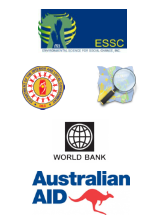About this document¶
This document was designed as a supplementary material for the “QGIS and InaSAFE Workshop” under the “Participatory mapping and LGU decision support tools for Disaster Risk Reduction” in partnership with the Department of Interior and Local Government, World Bank-East Asia Pacific and East Asia-AusAid Infrastructure for Growth program, OpenStreetMap-Philippines and the municipalities of of Candaba, Guagua, and Lubao, all in the province of Pampanga.
About the Project¶
The project will provide training on participatory mapping and InaSAFE support to the Philippine government in disaster risk reduction activities through these strategies:
- Supporting the growth of the OpenStreetMap community that has competence in leveraging participatory mapping methods with OpenStreetMap tools and Web-based map platforms and is a proven effective approach to community engagement and in obtaining data
- Supporting the customization of InaSAFE that will leverage the InaSAFE initiative with the decision support tool component of the project, having been developed and implemented in Indonesia so far. The Department of Interior and Local Government identified InaSAFE’s potential in assisting local governments design their contingency and land use plans.
At the end of the workshop, the participants should be able to:
- Understand the basic principles of how QGIS 2.0 works;
- Learn how to edit their existing dataset using QGIS;
- Understand the basic functionality of InaSAFE;
- Formulate a better land use and disaster risk reduction and management plans through the help of InaSAFE impact function results that may be later implemented in their respective municipality.
About ESSC¶
The Environmental Science for Social Change (ESSC) is a Jesuit research institute with a 20-year history of engagement in local, national and regional research and dialogue that contribute to an understanding and sustainability of community-based environmental management through the development of a “science for social change”.
ESSC’s approach to environmental mapping makes significant contribution to building people’s capacities to collectively manage and plan towards an improvement of their way of life through a more responsive management of the environment.
More information about ESSC: http://www.essc.org.ph
Conventions used¶
Menu and toolbar commands are shown as italic letters and (if available) preceded by an icon image, for example, or
 Composer Manager.
Composer Manager.A series of commands are written with . For example:
 New Project.
New Project.Keystroke combinations are shown as
Ctrl+B, which means press and hold theCtrlkey and then press theBkey.Code or variables are indicated by a fixed-width font, for example:
some commands or variables here
Note
Text within this box indicates a tip, suggestion, warning or caution.
Corrections and feedback¶
For corrections and feedback, contact Maning Sambale
emmanuelsambale@essc.org.ph
License of this document¶
Except where otherwise noted, content of this is licensed under GNU Free Documentation License.
Copyright (c) 2013 Environmental Science for Social Change.
Permission is granted to copy, distribute and/or modify this document under the terms of the GNU Free Documentation License, Version 1.3 or any later version published by the Free Software Foundation; with no Invariant Sections, no Front-Cover Texts, and no Back-Cover Texts.
A copy of the license is included in the section entitled Document License.
